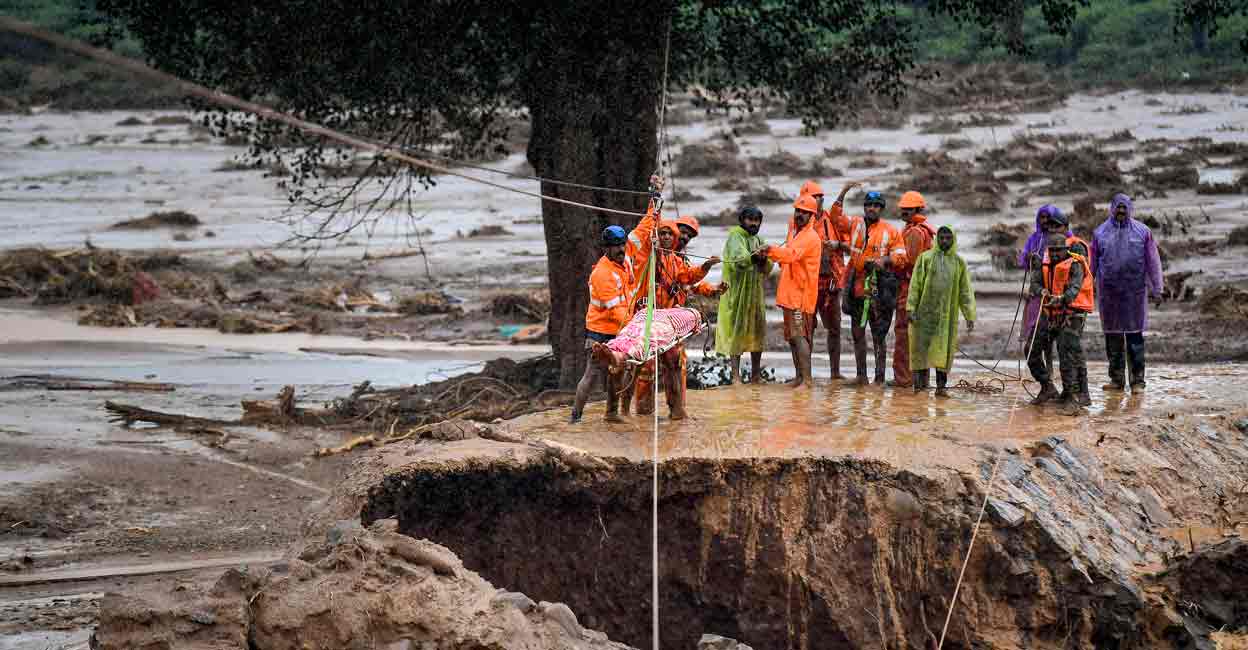Costly Lessons from Devastating Landslide I. Wayanad, Southern India and Gofa in Ethiopia within a Span of Just 10 Days

Within a span of just 10 days, huge landslides at two places have claimed over 500 human lives and threatened the displacement of thousands of people, bringing out in stark terms the fast increasing threat from landslides.
This tragic loss is in addition to the harm caused by several other relatively smaller landslides in various parts of the world, including the landslide-prone Himalayan region.
In the first tragedy in Gofa district of southern Ethiopia many homes in scattered rural settlements of foothill area were buried by stones and mud on July 20. Many people were buried in the rubble and villagers who quickly gathered on hearing their cries for help tried their best to rescue but could get only very limited success as they had only rudimentary tools like spades and shovels. Officials reached the site but well-equipped rescue teams could not reach in time to save many people. Some desperate villagers kept digging even with their hands to find survivors, including their near and dear ones.
However a second tragedy struck soon as there was another massive landslide which took away the lives of several those villagers who were engaged in rescue work. If better trained disaster rescue teams had come in time, it is likely that at least the loss of human lives in the second wave could have been prevented due to the better skills and training of the rescuers who could have anticipated the second landslide and taken adequate precautions.
Moreover the entire region was known for considerable time to be very prone to big landslides, a fact mentioned by local residents after the tragedy, and preventive actions should have been taken much earlier. Most of the houses were mud and tin constructions and the hills were affected by deforestation.
Nearly 257 people are reported to have died in this disaster. However the actual death toll may be much higher due to the many people buried in the rubble. The UN Office for the Coordination of Humanitarian Affairs had stated at an early stage of the tragedy that the death toll may go up to around 500.
The second huge landslide tragedy took place on 30 July in Wayanad district of Kerala state of India. Kerala has been highlighted worldwide for several of its higher development indicators but its many-sider ecological degradation and neglect are less widely known. This, together with higher concentration of rainfall in less time, as experienced several times in recent years, has made the state and the wider Western Ghats region more exposed to floods and landslides.

Rescue operation underway after a landslide triggered by heavy monsoon rains, in Wayanad district, July 30, 2024. Photo: PTI
In the early hours of July 30 three villages in particular suffered very serious harm, following the falling of the debris of a landslide of a nearby hill into a river, leading to a new ad deadly torrent of the river ravaging more hillsides, also moving towards human settlements, bringing death and destruction.
At the time of writing, the loss of over 180 human lives in this tragedy has been confirmed, while almost the same number of people are reported to be missing. At the same time, credit must be given to the teams which have rescued about 1500 people from the affected area, and taken up other supportive work, in very difficult conditions.
Soon after the tragedy prominent ecologist Madhav Gadgil, who was the Chairman of the Western Ghats Ecology Expert Panel, stated that such increasing tragedies in the state could have been avoided to a significant extent if the state government had given adequate attention to the recommendations made by the Ecology Expert Panel. He added that the affected area was of the category of highly ecologically sensitive area where indiscriminate construction and quarrying activities should have been carefully avoided.
The common lesson emerging from Gofa and Wayanad is that much higher attention and priority should be accorded to disaster protection and prevention at a time when threat from disasters is increasing due to several factors.
At a more immediate level, there is the urgent task of looking after the safety and other needs of those people who are either still living in high-risk areas close to where the landslides struck. The UN estimated that the number of such people in Gofa region alone may be close to 15,000. Only careful, participative analysis conducted with the close involvement of the affected communities can reveal how many of these people need to be moved to the safety of other areas. Clearly a lot remains to be done for these people, for those injured in these landslides as well as those families which have lost their main income-earners in these tragedies.
The wider challenge is to identify high-risk landslide zones carefully for important preventive action so that tragedies that can claim many lives whether by threatening settlements or roads and highways can be avoided.
Above all, there is need for ecologically sensitive and protective development policies in hilly regions that avoid deforestation, indiscriminate construction and mining.
*
Click the share button below to email/forward this article to your friends and colleagues. Follow us on Instagram and Twitter and subscribe to our Telegram Channel. Feel free to repost and share widely Global Research articles.
Spread the Truth, Refer a Friend to Global Research
Bharat Dogra is Honorary Convener, Campaign to Save Earth Now. His recent books include Protecting Earth for Children, Man over Machine, A Day in 2071 and India’s Quest for Sustainable Farming and Healthy Food. He is a regular contributor to Global Research.
Featured image: Search and rescue operations are still ongoing at the scene of the deadliest landslide scene in Kencho Shacha Gozdi village, gofa zone (Photo: Gofa Zone Communications Office/Facebook)

